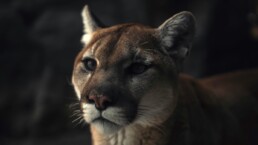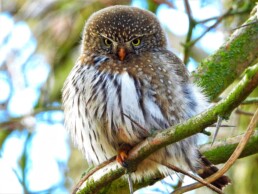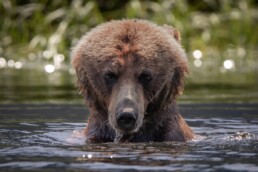Bighorn sheep are easy to identify and easy to spot near the city of Castlegar, British Columbia.
Bighorn sheep are an easily recognizable ungulate with iconic curved horns. As social animals, they spend most of the year in small herds with the rams in separate “bachelor groups.” Castlegar is actually outside of this species’ historic range, but a successful introduction program in the 1980s saw a herd established near Syringa Provincial Park, and they can easily be spotted on the hillsides surrounding the park, especially during the autumn months.
Also known as:
- Ovis canadensis
- kwiⱡqⱡI (Ktunaxa)
- sweláps (Secwepemc, secwepemctsin)
- scmítćaʔ (female), yilíkʷlxkn (male) (Syilx, nsyilxcǝn)
- sxʷƛ̓iʔ (Sinixt, snslxcin)
Description:
- Large wild sheep with massive, curling horns.
- Males stand 100cm at the shoulder and weigh 90-135kg with large horns that curve back, spiralling towards the eye.
- Females are two-thirds the size, with smaller horns that curve only slightly.
- Brown to grey coat with ivory rump patch and muzzle. They can look quite scruffy in early summer as their new coats grow.
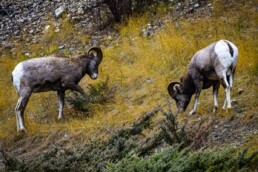
Habitat:
- Rugged, mostly treeless terrain with access to grasslands for foraging and with low snow cover in winter.
- They prefer to remain in areas with adequate “escape terrain” (steep, rocky terrain) where they can outmaneuver predators.
- The herd that lives near Syringa Provincial Park was introduced in the 1980s as it provides a unique grassland ecosystem with shallow snow cover and access to rocky escape terrain. This type of habitat is not common in the West Kootenay region.
Viewing Opportunities:
- The Syringa herd has seen a decline in the last decade but you can look for the sheep along the scenic Deer Park FSR just past Syringa Provincial Park.
- If you aren’t prepared for logging road travel, you can look for them from the beach at the aptly named ‘Bighorn Campground’ end of the park. Look for the rocky bluff above the lake at the eastern end of the park and scan the hillside with binoculars.
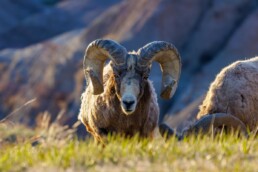
Behaviour:
- One of the most social ungulates in British Columbia.
- They travel in groups of 5-20 animals.
- For most of the year, males are in separate “bachelor groups” and the females form “nursery groups” with young sheep. The groups come together for the rut (breeding season) in fall or early winter.
- During the rut, males perform impressive mating displays that include head-butting other males.
- Their average lifespan is 12-14 years but they have been know to live up to 20. However, bighorn sheep have a high mortality rate in the first two years of life.
Diet:
- Bighorn sheep are herbivores that eat mostly grasses and sedges, but will also eat flowering plants, shrubs, and young trees.
- They will also lick mineral deposits from roadsides and from mineral-rich soil.
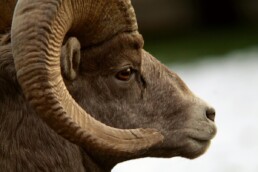
Connections:
- Two groups of bighorn sheep from the East Kootenay were introduced to the Syringa Creek area in the 1980s. This introduction was considered a wildlife conservation success story and the herd thrived for decades. Unfortunately, there has been a decline in the population in the last decade, due in part to cougar predation and the spread of invasive plants.
- Bighorn sheep are blue-listed (of special concern) in British Columbia. Given their very specific habitat requirements, they are sensitive to habitat loss and disturbance. They are also susceptible to stress-related diseases and diseases from domestic sheep.
- As with all wild animals, bighorn sheep should be given a wide berth and only enjoyed from a distance. It would not be fun to be head-butted by their big horns.
Cool Facts:
- Male horns can grow to 127cm long (around the curve) and as thick as 40cm around the base!
- Bighorn sheep have impact-absorbing horns and skulls which minimize the risk of brain injury during head-butting.
- Just before head-butting, blood vessels in the brain swell to create a tighter fit between the brain and skull, further protecting the ram from injury.
- All bighorn sheep have concave foot pads with a rough surface that act as “suction cups” for gripping rocky terrain.
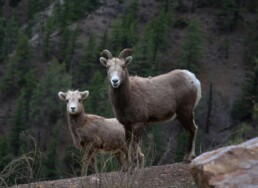
The goal of wildlife viewing is to safely appreciate the animals in their natural surroundings with minimal impact. To achieve that, here are eight tips:
- Be respectful. Getting too close or staying too long can disrupt feeding and other important behaviours and can cause stress and unpredictable behaviour.
- Give wildlife lots of space. If an animal responds to your presence (eg: looks up, watches you, moves away), you are too close.
- Viewing roadside wildlife can have negative impacts on wildlife by disrupting feeding and leading to habituation to traffic and people. If you spot wildlife while driving, pull over only if it is safe to do so and keep your stop short and sweet.
- Keep dogs on leash and under control at all times to avoid negative encounters
- Carry bear spray and know how to use it.
- Use binoculars and zoom lenses.
- Never feed wildlife.
- Leave no trace. Pack it in, pack it out.
Get To Know The Wildlife Of Castlegar
April 3, 2025
Meet Castlegar Photographer Jamie Isaacs
March 1, 2025
Meet Castlegar Photographer Josh Fogal
March 15, 2024


